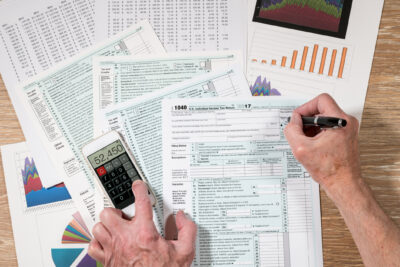
Organizing your tax documents is an ongoing process. Everyone can agree that preparing taxes requires a lot of processing and managing paperwork.
Document scanning is an integral part of properly preparing taxes. Knowing how to scan, save, and secure tax documents to build a strong document management program can help businesses and individuals safely file tax documents away for future access.
Guidelines for Saving Tax Documents
The guidelines for saving tax documents depend heavily on well-organized and maintained recordkeeping. Meticulous organization of tax documents can help answer any questions if your filing is selected for an audit by the Internal Revenue Service (IRS).
If the federal government has questions about your tax returns, it is easier to resolve when you can easily locate documents. Many tax experts suggest preserving tax records in digital format in case you or your beneficiary needs quick access to the information they contain.
Digitization is a common practice because the conversion process creates a backup of physical copies in case the original file is ever damaged or lost. Maintained and archived records help you maintain guidelines set by the IRS and common disaster recovery plans.
What Tax Documents Should Be Saved?
Before you can start scanning, you need to know what types of tax documents should be saved. According to the IRS, you must keep records such as receipts, canceled checks, and other documents that support an item of income, deduction, or credit appearing on your return.
Most tax documents that need to be saved are generated by one entity and sent to another. Sometimes the business or individual tax return filer produces their own individual tax documents.
Regardless of how tax paperwork and documents are produced, the following types of documents should be saved for year-end tax purposes:
- Mailed Tax Returns from Employers
- Real Estate Transactions
- Donations to Non-Profits
- Healthcare expenses and payments
- Investment, Retirement, and Bank Accounts
- Credit card statements, bills, and other receipts
- Proofs of payment
- Canceled checks
- Invoices
- Employee Business Expense or Mileage Logs
New technology and document management programs can make your annual tax filings easier by implementing innovative systems such as a digital mailroom. The software can account for all of your tax documents in one place.
Tax Document Scanning
Tax document scanning makes identifying tax documents and securing access with your accountant easier. Once documents are scanned into digital format, they can be filed away for future access and retrieval.
Tax documents often are referred to again while filing and reviewed by others. Creating digital folders to store scanned data sometimes is not enough. Document management programs often are the best solution, including scanning, saving, and eventually disposing of sensitive tax documents.
Aside from being an eco-friendly solution to paper records, document scanning can lead to comprehensive digital transformation within organizations and businesses.
How to Name and Save Scanned Tax Documents
Each item used on your tax return must be kept until that document’s period of limitations expires. Proper categorization and classification can help make identifying those items easier.
When you name and save scanned tax documents, place them in a folder with a proper label. For example, the title “2022 Tax Documents” will easily find the year’s tax information when needed.
As you name each document in the folder, include specific details or keywords about the document for easier identification and management. Filenames can include the name of the form, such as a W-2, and other details like who the document is from.
Processing Tax Documents
Scanned tax documents can be processed and implemented in document management and automation programs to reduce time-consuming tasks relating to audits and tax preparation.
Through a combination of day forward and backfile scanning, scanned documents can be integrated with paper-sourced information. Scanned documents then are transmitted to secure document scanning centers where optical character recognition technology (OCR) indexes and organizes tax-related documents in groups.
From here, data from unstructured documents can be converted into structured data to improve processes and make better, data-driven financial decisions.
Secure Retention or Disposal
Digitized tax records do not mean you must dispose of all physical copies after scanning. A tax document retention schedule and policy ensure your record-keeping requirements meet legal compliances and prevent unwanted problems regarding tax information.
The IRS and most record retention schedules provide guidelines as to what documents must be saved and how they are saved.
- Normally, tax reports should be kept for a minimum of 7 years.
- Documents for property sales, purchases, and transactions should always be maintained.
Documents often become irrelevant after a set time has passed. In that case, documents can be securely shredded.
Benefits of Digital Tax Records
Since 1997, the IRS has accepted electronic documents as proof for any tax-related questions (as long as they are legible and readable, of course). Digital tax records pose a plethora of benefits but are widely used by tax professionals due to their instant ability to be viewed across different computers and devices.
Outsourcing your document management program is often an economical option that allows tax filers to spend less time on tasks and more time on the things that matter to you. Having a well-organized document management system that manages digital tax records keeps your information safe and secure.
Digital tax records cannot be lost or stolen. Since information is stored electronically in the cloud, documents take up no physical space, so you don’t even need to buy a file cabinet.
Other benefits to digital tax records include:
- Tax error prevention
- Automatic data entry and calculation
- Faster audits AND refunds
- Easier access to relevant information
Beyond taxes, document scanning can help you have access to other important documents, save space, and better serve your bottom line.
If you’re ready to modernize your tax filing process, request a sample scan from Didlake Imaging to see how our document scanning program can help you save, secure, and retrieve your tax records.

